Russian Orthodox cross
 8-pointed Russian cross |
 6-pointed Russian cross |
 |
 |
Russian Orthodox cross (Russian: Русский православный крест), also known as Orthodox or Byzantine or Suppedaneum cross, is a variation of the Christian cross, a symbol of the Russian Orthodox Church[1][2][3] and a distinctive feature of the cultural landscape of Russia[4]. The cross has three horizontal crossbeams and the lower one is slanted.
It was introduced in the 6th century before the break between Catholic and Orthodox churches. It was used in Byzantine frescoes, arts and crafts. In 1551 during the canonical isolation of the Russian Orthodox Church the Grand Prince of Moscow Ivan the Terrible for the first time in history started to use this cross on the domes of churches[5]. In addition from this time it started to be depicted on Russian state coat of arms and military banners. In the second half of 19th century this cross was promoted by the government of Russian Empire in the former Grand Duchy of Lithuania as a part of Russification politics[6].
According to some sources the Russian Orthodox cross has only two horizontal crossbeams and the lower one is slanted[7]. Some Russian sources distinguish the Russian Orthodox cross and the Orthodox cross[8]. In Unicode the symbol (☦) is denoted as Orthodox cross[9]. The same USVA headstone emblem is called Russian Orthodox cross[10].
Name

According to many sources[1][11][12][13][14][15][16][17][18][19][20][21] the name of the three beam slanted cross is Russian (Orthodox) cross (Russian: Русский православный крест[2][22][23][24][25][26][27]).
Sometimes it is also called Byzantine cross[17]. At the same time the Byzantine cross is also the name for a Latin cross with outwardly spreading ends. It was the most common cruciform in the Byzantine Empire. Other crosses (patriarchal cross, Russian Orthodox cross, etc.) are sometimes misunderstood as "Byzantine cross" when they are from the Byzantine culture.
Sometimes it is also called just Orthodox cross[18]. At the same time the Orthodox churches use different crosses and any of them is called "Orthodox cross"[28]. Moreover, there are no such crosses like just "Orthodox" or "Catholic", each type of cross is a feature of local tradition[4].
Meaning
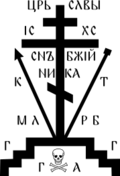
The cross has three horizontal crossbeams — the top one represents the plate which in the older Greek tradition is inscribed with a phrase based on John's Gospel "The King of Glory", but in later images it represents INRI, and the bottom one, a footrest. In many depictions, the side to Christ's right is higher. This is because the footrest slants upward toward the penitent thief St. Dismas, who was (according to Russian tradition[3][29]) crucified on Jesus' right, and downward toward impenitent thief Gestas. It is also a common perception that the foot-rest points up, toward Heaven, on Christ’s right hand-side, and downward, to Hades, on Christ’s left.
In Russia, the top crossbeam can be absent; however, in the Russian North it can be attached on top of the vertical beam[30].
A variation is a monastic "Calvary Cross", in which the cross is situated atop the hill of Calvary, its slopes symbolized by steps. To the viewer's left is the Holy Lance, with which Jesus was wounded in his side, and to the right, a pole topped by a vinegared hyssop sponge. Under Calvary are Adam's skull and bones[31]; the right-arm bone is usually above the left one, and believers fold their arms across their chests in this way during Orthodox communion. Around the cross are abbreviations in Church Slavonic. This type of cross is usually embroidered on a schema-monk's robe.
Current usage
The Russian (Orthodox) cross (☦) is traditionally widely used by Russian Orthodox Church. Now it's also widely used by Polish Orthodox Church and Czech and Slovak Orthodox Church, which received their autocephaly from Patriarch of Moscow in 1948 and 1951 respectively. Sometimes this cross is used by the Ecumenical Patriarchate of Constantinople (e.g. in American Carpatho-Russian Orthodox Diocese).
Though commonly associated with the Russian Orthodox Church, this version is found also in the Byzantine frescos of churches, which now belong to Greek and Serbian Orthodox churches[32].
History
According to documentary evidence, the slanted cross with three horizontal crossbeams existed already in the 6th century, long before the Great Schism. However, it was used only in church paintings, arts and crafts, and never on the church domes. There are old frescoes depicting this type of cross on the territory of modern Greece and Serbia.
At the end of the 15th century this cross started to widely used in Muscovy when its authorities have declared themselves "Third Rome" and defenders of the purity of Orthodoxy[33]. In 1551 at the council of canonically isolated Russian Orthodox Church the Grand Prince of Moscow Ivan the Terrible decided to unify the shape of a cross on the Russian church domes to protect Muscovy from the "Lithuanian, Polack cross"[34]. From this time the Russian Orthodox Cross for the first time in history started to be used on the domes of churches. Between 1577–1625, the Russian Orthodox cross was depicted between the heads of a double-headed eagle in the coat of arms of Russia. It was drawn on military banners until the end of the 17th century[35].
In 1654, the Moscow council removed from the liturgical practice of the Russian Orthodox Church the divergence from other Orthodox churches, which were formed during the time of its canonical isolation (1448-1589)[36] as the Russian national features[37]. At this council Patriarch Nikon ordered to use Greek cross instead of Russian Orthodox cross, which, combined with other changes caused Raskol[38]. Replacement of Russian Orthodox cross by Greek cross was caused by disrespectful attitude in Russia to the second one[26]. Soon, however, Russian Orthodox Church began to use the Russian Orthodox cross again. Thus, according to the Metropolitan of Ryazan and Murom Stefan the Russian Orthodox cross was wearing by Peter I[33] (1672-1725), who transformed the Moscow Patriarchate in the Most Holy Synod.
In the 19th and 20th centuries the Russian Orthodox cross was promoted by the government of Russian Empire and USSR on the territory of modern Belarus, Poland and Ukraine as a part of Russification politics[29][39][40]. In the end of the 20th century and the beginning of the 21st century Russian Orthodox Church replaced many traditional Greek Orthodox crosses in Belarus by the Russian Orthodox crosses[4].
The Russian Orthodox cross is depicted on emblems of several Russian ultra-nationalist organizations such as Brotherhood of Russian Truth and Russian National Unity.
Gallery
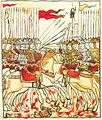 A 17th-century miniature of the Battle of Kulikovo (1380). A warrior bears a red banner with a cross
A 17th-century miniature of the Battle of Kulikovo (1380). A warrior bears a red banner with a cross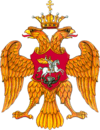 Coat of arms of Russia from the seal of Ivan IV (the Terrible), 1577
Coat of arms of Russia from the seal of Ivan IV (the Terrible), 1577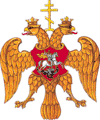 Coat of arms of Russia from the seal of Fyodor I, 1589
Coat of arms of Russia from the seal of Fyodor I, 1589 Russian military flag, 1696—1699
Russian military flag, 1696—1699 Russian military flag, 1706
Russian military flag, 1706 A copper cross typical for Old believers
A copper cross typical for Old believers A cross of a Russian Orthodox priest
A cross of a Russian Orthodox priest A modern memorial to Ss. Cyril and Methodius in Khanty-Mansiysk, Russia
A modern memorial to Ss. Cyril and Methodius in Khanty-Mansiysk, Russia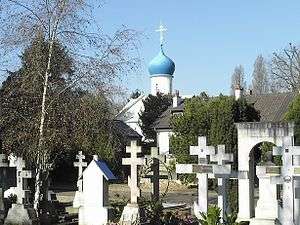 Sainte-Geneviève-des-Bois Russian Cemetery, the resting place of many eminent Russian émigrés.
Sainte-Geneviève-des-Bois Russian Cemetery, the resting place of many eminent Russian émigrés. Białystok (Poland): on the domes of the Church of the Holy Spirit
Białystok (Poland): on the domes of the Church of the Holy Spirit Johnstown, Pennsylvania: Christ the Saviour Cathedral of American Carpatho-Russian Orthodox Diocese (belongs to the Ecumenical Patriarchate of Constantinople)
Johnstown, Pennsylvania: Christ the Saviour Cathedral of American Carpatho-Russian Orthodox Diocese (belongs to the Ecumenical Patriarchate of Constantinople) Svidník (Slovakia): the cross in front of the church
Svidník (Slovakia): the cross in front of the church The flag for the Brotherhood of Russian Truth
The flag for the Brotherhood of Russian Truth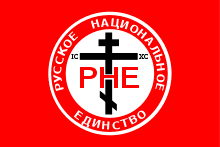 Flag of RNU
Flag of RNU
See also
References
- 1 2 Liungman, Carl G. (2004). Symbols - Encyclopedia of Western Signs and Ideograms. Ionfox AB. p. 140. ISBN 978-91-972705-0-2.
- 1 2 Святейший Патриарх Московский и всея Руси Кирилл. Воздвижение Честного и Животворящего Креста Господня // Тихвинский листок №41, 27 Сентября 2017.
- 1 2 Фещин А. Довірся Хресту // Християнский голос. — 2002. — № 18 (2854). С. 232.
- 1 2 3 Бурштын Я. Ірына Дубянецкая: Дзякуючы намаганням РПЦ пачынае мяняцца культурны ландшафт Беларусі (Фота і відэа) // Служба інфармацыі «ЕўраБеларусі», 16 ліпеня 2016 г.
- ↑ Русский крест: символика православного надглавного креста. — Москва, 2006. С. 149.
- ↑ Мілаш Я. Традыцыі ўшанавання крыжа беларусамі ў канцы XIX ст. // Наша Вера. № 3 (65), 2013.
- ↑ Рэлігія і царква на Беларусі: Энцыкл. даведнік — Мн.: БелЭн, 2001. С. 168.
- ↑ "Православные кресты: как разобраться в значениях" [Orthodox crosses: how to understand the meanings] (in Russian). 30 September 2011. Retrieved 21 February 2018.
- ↑ Unicode Character 'ORTHODOX CROSS' (U+2626).
- ↑ Available Emblems of Belief for Placement on Government Headstones and Markers, Supreme Court of the United States
- ↑ Thomas, Robert Murray (2007). Manitou and God: North-American Indian religions and Christian culture. Greenwood Publishing Group. pp. 121–122. ISBN 978-0-313-34779-5.
- ↑ Milo D. L. The Ankh: Key of Life. — Weiser Books, 2007. P. 13.
- ↑ Mori J. Crosses of Many Cultures. — Harrisburg, 1998. P. 38.
- ↑ Joseph L. Young. Mosaics: principles and practice. — Reinhold, 1963. P. 99.
- ↑ Koch R. The Book of Signs. — New York, 2000. P. 17
- ↑ The Grove Encyclopedia of Medieval Art and Architecture, Volume 1. / Edit. Colum Hourihane. — OUP USA, 2012. P. 221.
- 1 2 Becker U. The Continuum Encyclopedia of Symbols. — New York London, 2000. P. 71.
- 1 2 Chwalkowski F. Symbols in Arts, Religion and Culture: The Soul of Nature. — Cambridge Cholars Publishing, 2016. P. 112
- ↑ Ryskt kors, Nationalencyklopedin.
- ↑ Kors, Store norske leksikon
- ↑ Benker S. Liturgische Geräte, Kreuze und Reliquiare der christlichen Kirchen / Objets liturgiques, croix et reliquaires des eglises chretiennes. Walter de Gruyter, 2011. S. 68.
- ↑ Из проповеди Святейшего Патриарха Кирилла в праздник Воздвижения Честного и Животворящего Креста Господня После Божественной литургии в Успенском кафедральном соборе Астраханского кремля // Ахтубинские епархиальные ведомости. №7 (48), июль — октябрь 2017. С. 7.
- ↑ Юсупов С.Э. Словарь терминов архитектуры. Фонд "Ленинградская Галерея", 1994. С. 185.
- ↑ Королев К. Энциклопедия символов, знаков, эмблем. — Мидгард, 2005. С. 314.
- ↑ Православный календарь на 2016 год. — Litres, 2017. С. 87
- 1 2 Русский крест: символика православного надглавного креста. — Москва, 2006. С. 147.
- ↑ Архиепископ Афанасий (Мартос). Восьмиконечный русский крест // Миссионерский Листок. №144. — Свято-Троицкая Православная Миссия, 2003.
- ↑ "Православные кресты: как разобраться в значениях" [Orthodox crosses: how to understand the meanings] (in Russian). 30 September 2011. Retrieved 21 February 2018.
- 1 2 Яременко В. Золоте Слово: Хрестоматія літератури України-Русі епохи Середньовіччя IX—XV століть. Книга перша. — Київ: Аконіт, 2002. С. 485.
- ↑ Kuznetsov 1997.
- ↑ McGuckin, John Anthony (2011). "Cross". In John Anthony McGuckin. The encyclopedia of Eastern Orthodox Christianity. 1. John Wiley and Sons. p. 170. ISBN 978-1-4051-8539-4.
- ↑ Gerstel, Sharon (2006). "An Alternate View of the Late Byzantine Sanctuary Screen," in Thresholds of the Sacred: Art Historical, Archaeological, Liturgical and Theological Views on Religious Screens, East and West, ed. S. Gerstel. pp. 146–47.
- 1 2 Гнідець Р. Св. Хрест, його форма та різновиди в Україні // Греко-Католицька Традиція №9 (193), вересень 2013 р.
- ↑ Белы А. Крыж Еўфрасінні Полацкай // Наша Слова. № 29 (817) 1 жнiўня 2007 г.
- ↑ Shpakovsky, Viacheslav; Nicolle, David; McBride, Angus (2006). "Infantry and cavalry banners". Armies of Ivan the Terrible: Russian Troops 1505-1700. Osprey Publishing. p. 23. ISBN 978-1-84176-925-7.
- ↑ Мицик Ю. Московський Патріархат // Енциклопедія історії України : у 10 т. / редкол.: В. А. Смолій (голова) та ін. ; Інститут історії України НАН України. — К.: Наук. думка, 2010. — Т. 7 : Мл — О. С. 87.
- ↑ Нуруллаев А. А. Нуруллаев А. Ал. Религия и политика. — М., 2006. С. 299.
- ↑ Изотова О., Касперович Г., Гурко А., Бондарчик А. Кто живет в Беларуси. — Минск: «Беларуская навука», 2012. С. 740
- ↑ Щербаківський В. Чи трираменний хрест із скісним підніжком – національний хрест України? // Визвольний шлях. — 1952, листопад. — Ч. 11 (62). С. 33—34.
- ↑ Білокінь С. Українська форма хреста // Укр. слово. — 1994. — № 17 (2713).
External links
| Wikimedia Commons has media related to Category:Russian Orthodox cross. |
- "Explanation of the Three-Bar Cross". Church of the Nativity: Russian Orthodox Old Rite. Retrieved October 20, 2011.
- V. Rev. John Shandra. "The Skull on the 'Russian' Orthodox Cross". Retrieved October 20, 2011.
- Kuznetsov, V. P. [Кузнецов В. П.] (1997). History of the development of the cross's forms. Short course of Orthodox staurography [История развития формы креста. Краткий курс православной ставрографии] (in Russian). Moscow.
